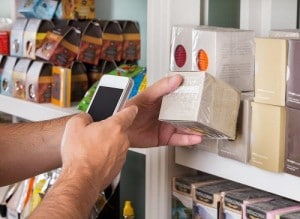 A non-profit called Environmental Working Group (EWG) has recently unveiled “Food Scores,” a soon-to-be-released app consumers can use to scan bar codes on packaged food items with their smart phones. Beyond the mandatory labeling on the package, consumers can, for the first time, have an easily understandable reference tool that helps them understand a product’s implications to their health.
A non-profit called Environmental Working Group (EWG) has recently unveiled “Food Scores,” a soon-to-be-released app consumers can use to scan bar codes on packaged food items with their smart phones. Beyond the mandatory labeling on the package, consumers can, for the first time, have an easily understandable reference tool that helps them understand a product’s implications to their health.
Food Scores is based on a simple 1 to 10 scale with a color gradient from green to red. The number 1 (green) is the best score, and 10 (red), is the worst score. The score is a combination of ratings for nutrition, ingredients, and processing. The EWG’s website says regarding nutrition, “We’ve always wanted to eat healthier, but it’s not always easy to know how.” Regarding ingredients, it says, “Pesticides, food additives, contaminants, and antibiotics matter too.” And on processing, “Whole foods are healthiest; EWG helps point you to less processed options.”
Ken Cook, President and founder of EWG, says, “Ingredients that are added to food purely for the convenience of industrial food makers are under scrutiny, not by regulatory agencies, but by the public.” The premise is simple. The mandatory list of ingredients and nutritional data on packages are too limited and understate the total effects of the product on your health. This more comprehensive analysis will provide consumers with a quick reference to rate their brand choices beyond those mandatory regulations. Food Scores includes animal welfare standards, presence of antibiotics, exposure to environmental contaminants and pesticides, for instance.
The Grocery Manufacturers’ Association was quick to attempt to discredit the new app, saying that their ratings where flawed and “not based on sound scientific methodologies.” However, the non-profit counters with the fact that the groups methodologies are “presented in depth on the website” for consumers. From a marketing stand point, the consumers will be the judges about the credibility of the scoring methods. That, combined with the public concern about ingredients and processing, will drive the popularity of this new app.
Food Scores will change shopping habits by educating the general public about health factors related to over 80,000 packaged food items on U.S. grocery store shelves. Both Gatorade and Kraft Macaroni and Cheese have already reformulated their food products to be more in tune with a more educated consumer.
The implications to consumer packaged food brands is game changing. Very soon, these brands will have to position themselves closer to a score of 1 and further from 10 to satisfy their better educated consumers. Early adaptors will see this as an opportunity to embrace the score and use it to distinguish their products. Getting in front of this sea change will be the new marketing challenge, especially for old school producers who have elevated their own production needs over those of marketing and sales.
EWG has already had a significant impact on the cosmetics and skin care industry with a similar app, “Skin Deep,” that changed the views of many women from just putting on makeup to putting on chemicals. This forced some cosmetic companies to improve their products, and benefit from their new distinction.
For years we have said that people vote with their purchases. We think that Food Scores and other similar apps will become a catalyst that will change the way packaged food brands position themselves in the marketplace. Progressive companies will build their brands on scores of 1 to 3 and demand healthier farming practices on the part of their supply chains. The genie is out of the bottle!


